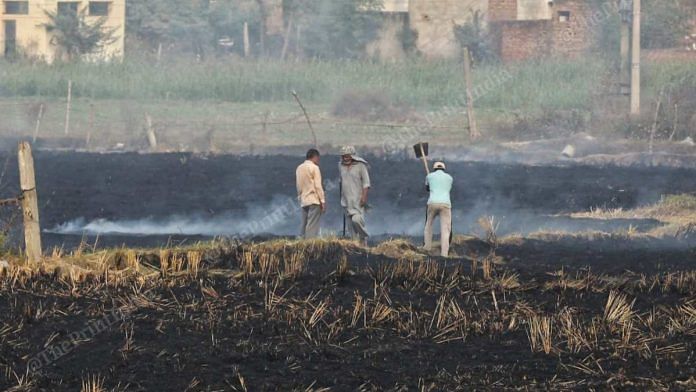Chandigarh: Large plumes of thick smoke billowing from agricultural fields and then extending onto highways are a common sight in rural Punjab every year.
When ThePrint traveled through various regions in the last week, fields after fields were found to have been set afire, leading to a thick blanket of smoke hanging in the air.
The farm fires were raging in Mansa, Sangrur and Patiala districts from 6-8 November. On 9 November, fewer fields in areas around Patiala district were set ablaze as this reporter made her way from Chandigarh to Sangrur.
Every winter, stubble burning in the neighbouring states of Punjab, Haryana and Uttar Pradesh during October-November leaves Delhi gasping for breath.
Stubble burning is the cheapest option available to farmers to clear their agricultural fields. By burning the residue left on the land after harvesting, farmers ready the soil for the next round of seeding.
The number of stubble burning incidents in this paddy harvest season has crossed 60,000. ThePrint had reported earlier that such incidents this year is 67 per cent higher than last year and even double the number in 2018.
When ThePrint approached the farmers at these fields, they were reluctant to speak. Some even ran away and objected to recording of stubble burning incidents.
But farmer unions said farmers burn stubble “out of desperation” as machines are expensive and the government needs to increase the subsidy on those machines.
The Punjab government, meanwhile, said while the incidents of farm fires have gone up this year, the area of fields being burnt hasn’t increased.
Also read: Stubble burning could decline this week but Delhi unlikely to get respite from toxic air soon
Govt subsidy on machines isn’t enough, say farmer unions
Farmer union leaders said farmers know the health and environmental hazards of burning stubble, but they are left with no choice.
“Farmers burn stubble out of desperation. We know it causes pollution. The first victim is the farmer, who also suffers respiratory diseases because he is the one who lights the fires. But what choice do we have?” said Jagmohan Singh, general secretary, Bharatiya Kisan Union (Dakonda).
Farmers said they need machines to avoid stubble burning, but they are expensive and the government subsidy isn’t enough.
“We need machines, which will cut and sow the seeds (for the next season) faster. We also need bigger tractors. But these machines are expensive. The state government gives them at a subsidised cost. But if the machine costs Rs 4 lakh and the government gives it at Rs 2 lakh, the farmer still has to pay Rs 2 Lakh. Where will that come from?” Singh said.
Farmers also said the state government hasn’t given them the compensation as ordered by the Supreme Court in 2019.
“The Supreme Court had said farmers should get Rs 100 per quintal incentive for not burning stubble. But the Punjab government has not released a single rupee to any farmer in a year. Yet now they want to impose penalties on farmers for stubble burning,” said Joginger Singh Ugrahan, chief of Bharatiya Kisan Union (Ekta Ugrahan).
Farmers also pinned blame on the government for not allowing diversification of crops.
“We don’t just want to cultivate paddy. We want to diversify and cultivate other crops. Cultivating paddy harms the soil as well as ground water. It also needs a large amount of pesticides and fertilisers, which affects the soil,” Singh added.
Ugrahan said farmers are bearing the brunt of state government’s failures.
“The government hasn’t found fast solutions and the Centre is only interested in imposing fines. Neither of them is trying to understand the farmers’ problems,” he said.
Also read: Why Punjab’s farmers continue to burn stubble and poison Delhi’s air
Govt looking at sustainable solutions
Punjab Chief Secretary Vini Mahajan, however, told ThePrint the government is looking at sustainable solutions to curb stubble burning.
“The number of stubble burning incidents is not the best indicator of the situation. We have been looking at the area of the field being burnt. Our intent is to reduce the impact on the environment. For instance, if two small heaps are set on fire and one acre field is set on fire, the number of incidents is more in the first case, but the second case is covering a larger area and causing more harm. So while incidents have increased this year, the area has not increased,” said Mahajan.
“One of the main problems with paddy soil is that it cannot be used as fodder. So we are looking at diversifying into basmati paddy, which can be used as fodder. In addition, we are looking into microbial solutions through microbes that dissolve the stubble and convert it into nutrient for the soil,” added Mahajan.
The chief secretary also said that the trials are going on across several thousand acres of land and the government has also developed several projects for generation of bio-CNG and bioethanol from paddy straw.
Asked about the rising instances of stubble burning amid the Covid-19 pandemic, Mahajan said the government is working on awareness programmes to stop farmers from burning stubble so to protect both human health and environment.
Also read: Punjab’s protesting farmers playing into Modi govt’s hands, says state Congress chief






